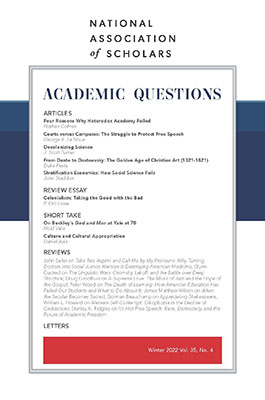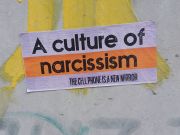The Death of Learning: How American Education Has Failed Our Students and What to Do about It, John Agresto, Encounter, 2022, pp. 256, $27.99 hardbound.
Peter Wood is the Executive Editor of Academic Questions and President of the National Association of Scholars.
Despite the dire title, John Agresto’s new book is a rather sunny manifesto. The familiar parade of horribles advances through seventeen short chapters and six appendices, but always offset by Agresto’s buoyant spirit. Things are never so bad in American education and American culture but that they might happen to get better. His optimism has roots in many places. A former president of St. John’s College, he knows that the Great Books, if given half a chance, can light up the minds of students. As former president of the American University of Iraq (in the Kurdish region), he witnessed how students who had been constrained under the old regime to narrow technical educations embraced a serious liberal arts education.
And Agresto looked to his own upbringing in a “fairly poor Brooklyn family.” His father was a day laborer who poured cement and who hoped his son would get into a union and become a dock worker. His house had a grocery store Book of Knowledge, but was otherwise “almost without books.” School was not disdained but certainly wasn’t extolled. Agresto does not present himself as possessed of some Keatsian genius with which he soared aloft from such humble origins. Rather, an eighth grade teacher, Sister Mary Gerald, thrust on him a work of modest literature, Booth Tarkington’s pre-World War I story, Penrod and Sam, about two boys who amble into minor adventures. They play war games, for example, create a secret society, and take possession of a stray horse.
All at once, at what must have been age thirteen or fourteen, John discovers the power of imaginative literature. This doesn’t turn him into a bookworm—at least not yet—but sets him on the path of Penrodian emulation. He inspires his play fellows to form their own secret society and to whoop it up in classic boyhood style. Adult Agresto could have cited the opening chapters of Huckleberry Finn, where Tom Sawyer likewise organizes a secret society of would-be stagecoach robbers. Fictional Tom, like real-life John, gets his idea from reading a book or two. There is a tradition in everything.
Is the true foundation of a liberal arts education then to be found in Penrod and Sam? Agresto doesn’t quite say so, but there is something to the idea in all the essays that follow. He spends his first chapter mostly saying what a liberal arts education is not. Not just history and literature. Not woke activism. Not learning for its own sake. Not the opposite of a practical education. Not just whatever a college says is mandatory. Not the classical “seven liberal arts.” At the end of this list of negations, Agresto broaches on what he regards as some of the real characteristics, though they are hardly of the sort that would help the novice distinguish a tasty morsel from a destroying angel: “The liberal arts are those studies that help make [men and women free].” (Italics in the original) He expands on what kind of freedom: “The liberal arts hold out the promise of freeing each of us from the captivity of prejudice, of platitudes and superstition , or whatever it is that ‘everyone’ believes.”
Of course, a great many contemporary faculty members see themselves as engaged precisely in this kind of liberation when they seek to “free” their students from love of country, belief in God, the worthiness of Western civilization, respect for their parents, the pursuit of truth, the rule of law, and all the other forms of “oppression” that American teenagers may have groaned under. It is to Agresto’s credit that he spends no time at all on refuting such sophistries. Rather, he sets his eyes on two better goals, both of which he believes have been disserved often as much by the professed friends of the liberal arts as by their pronounced enemies.
The first of these goals is so to speak, Penrod and Sam. The liberal arts, properly understood, are not just about liberating our minds from “rote thinking,” but about liberating our “imaginations . . . to see things not only more truly but also differently . . . to imagine new ways of play and adventure after reading even so simple a book as Penrod and Sam.” This includes the far less simple ways of play that comprise the Iliad, the plays of Shakespeare, and the writings of Madison.
The second goal is to take seriously the substance of great writers and thinkers. Agresto opposes the sort of study that treats books as taxidermied specimens of some by-gone era. Tracing who influenced whom and what great social issues of the day prompted the writer are distractions from what really matters: whether the authors actually have something to say that is worth our attention. “Great literature is always new, always contemporary, always relevant. . . it can transform our view of ourselves and the world.” Wordsworth, for example, is “great because he has something to say, and in a manner worthy of our attention—not because he’s a good example of Romanticism.”
In both points—in the liberation of our imaginations, and in reading great literature for the truths and wisdom it contains—Agresto boldly demonstrates how out of step he is with the prevailing ethos of the modern university. He is perfectly aware of this and not the least bit embarrassed. In each chapter he picks away at the conceits of the contemporary university and the feeble excuses provided by the faux protectors of the liberal arts for their catastrophic failures. Some of these points bear comment.
Agresto, for example, opposes any neat division between liberal learning and the acquisition of work-related skills. The workman can find time for rich intellectual reflection, and those ostensibly devoted to liberal learning may be mired in otiose intellectual specialization, abstract nonsense, or purblind politics. Liberal education and quotidian work are not the same thing, but they need not be set in opposition. Agresto does not say, but he could easily point to examples of figures such as Ludwig Wittgenstein, whose intellectual lucubration was accompanied by a life of toil. Of course, voluntary toil differs from the grind of toiling for existence when the academy rejects you, such as the fate of Jude Fawley, the subject of Thomas Hardy’s Jude the Obscure.
Agresto writes in so winsome a fashion that it seems a bit churlish to point out what I take to be missteps, but the reviewer is duty-bound. In an early chapter extolling the successes of men in practical life who have made good use of their liberal arts education, Agresto cites Martin Luther King, Jr. and Anthony Fauci. King is certainly a man of high accomplishment, but his “liberal arts” record, as we know from the Stanford King papers project, is of limited account. King was a serial plagiarist as an undergraduate, a habit he carried into his Boston University doctoral dissertation which was almost wholly plagiarized from the dissertation of an earlier student, Jack Boozer, and a mélange of unattributed passages stolen from the theologian Paul Tillich. King’s greatness as statesman has to be understood despite his education, not because of it. As for Fauci, I would violate Agresto’s strictures on moderation were I to dwell with any emphasis on his vainglorious usurpation of scientific authority to advance disastrous policies justified as emergency health measures. If this is the best we can do as an exemplification of the value of a liberal arts education, we had best repent immediately of the whole idea.
But that is really the only serious misstep in a book that manages to cover the morally and intellectually ruinous terrain of the contemporary higher education without falling into despair. Agresto, rightly I think, trusts that human thirst for knowledge is deeper than the human temptation to indulge in triviality and self-delusion. He offers some specific examples of tendrils of liberal learning pushing their way through the sterile quad of the postmodern university, but it is Agresto’s example rather than Agresto’s examples that most make the book worth reading.
I would add that The Death of Learning might be seen as a complete inversion of the agenda long advanced by Stanley Fish, who promotes what he calls “academicizing” the topics in higher education. Per Fish: “To academicize a topic is to detach it from the context of its real world urgency, where there is a vote to be taken or an agenda to be embraced, and insert it into a context of academic urgency, where there is an account to be offered or an analysis to be performed.”1 Both Agresto and Fish oppose the use of the classroom for proselytizing political dogmas, but Fish hopes to get there by draining the classroom of any connection to the vital issues of right and wrong, the best regime, joy and sorrow, or the purpose of life. “An account to be offered” is emotional and spiritual famine food. Agresto, by contrast, invites us to a feast.
1 Stanley Fish. Save the World on Your Own Time (Oxford University Press. 2008), 27.
Photo by Blogging Guide on Unsplash













